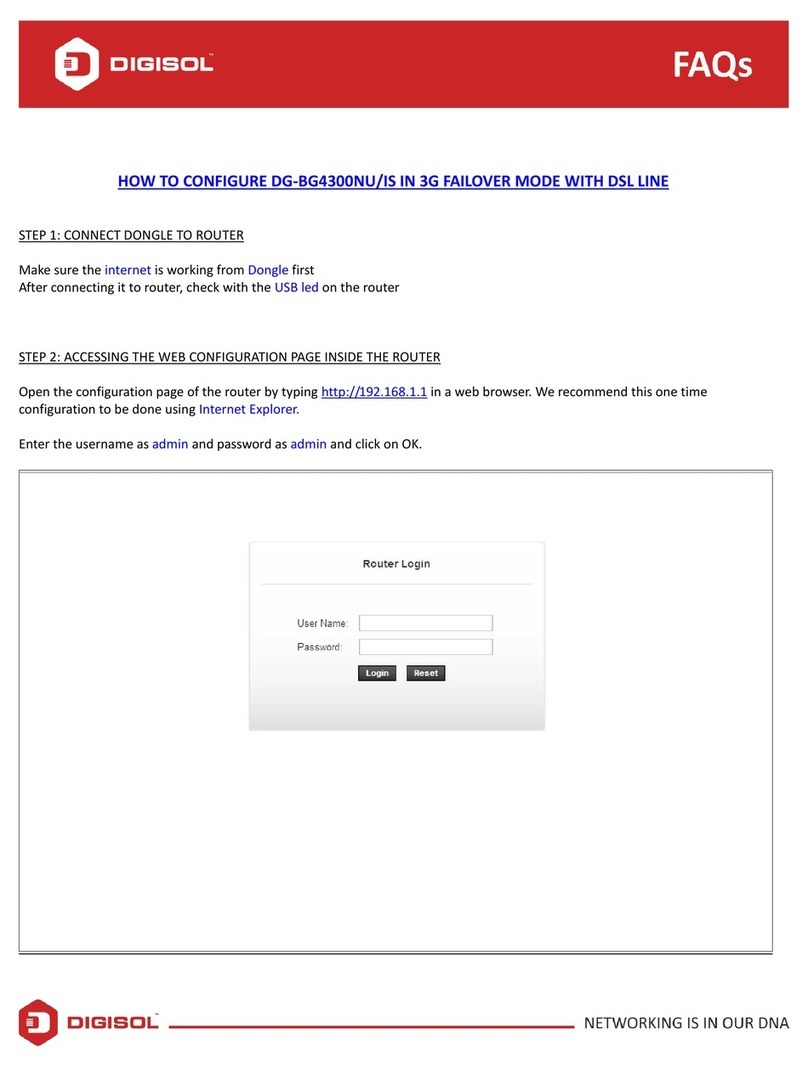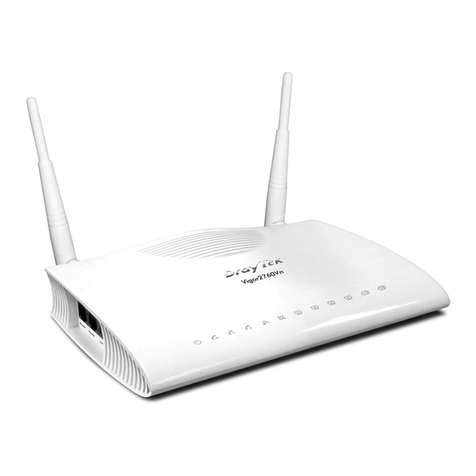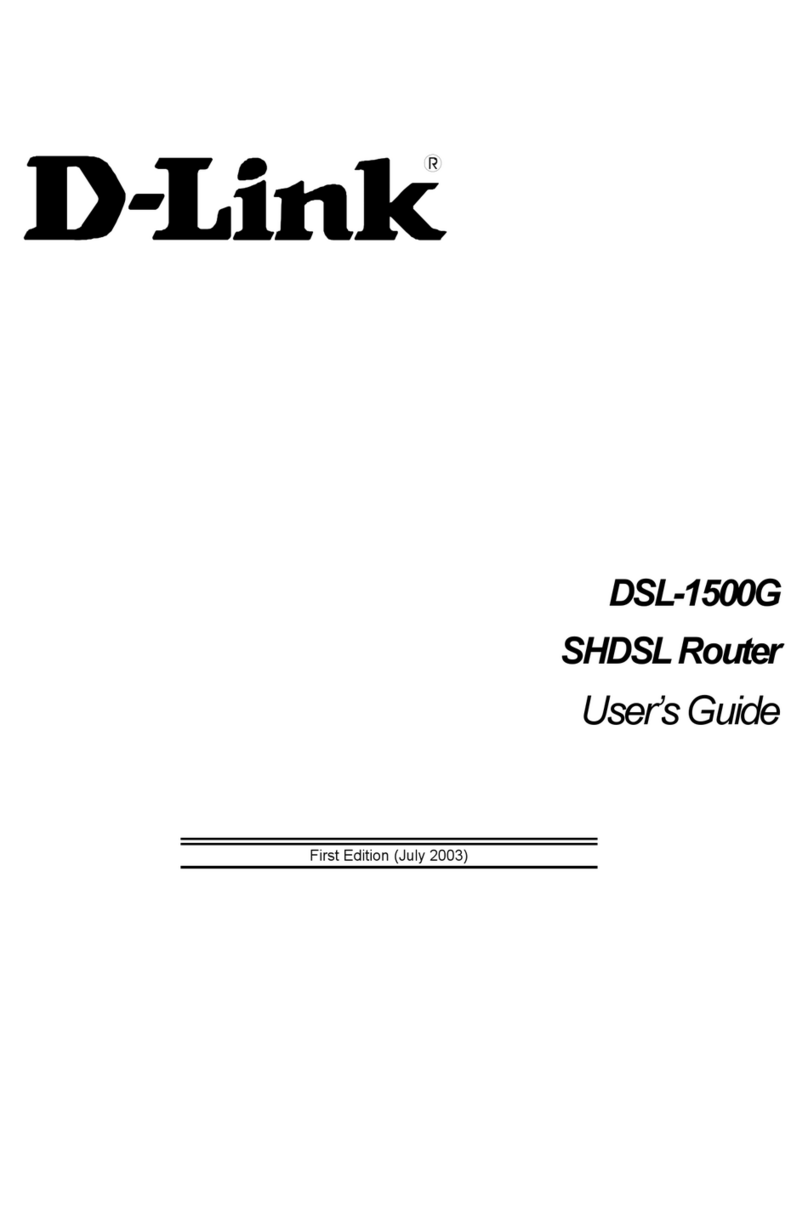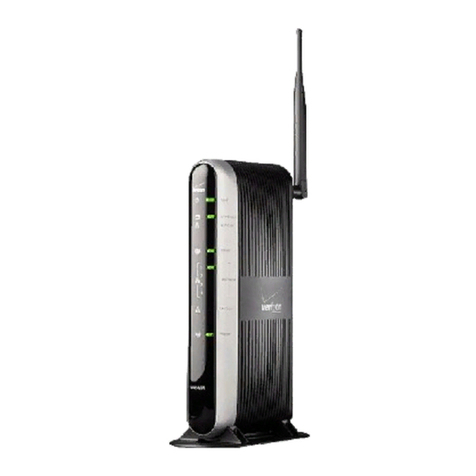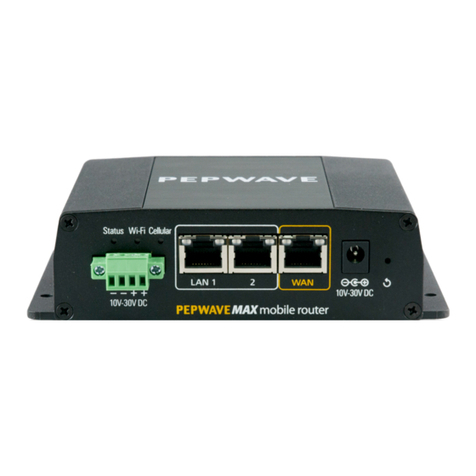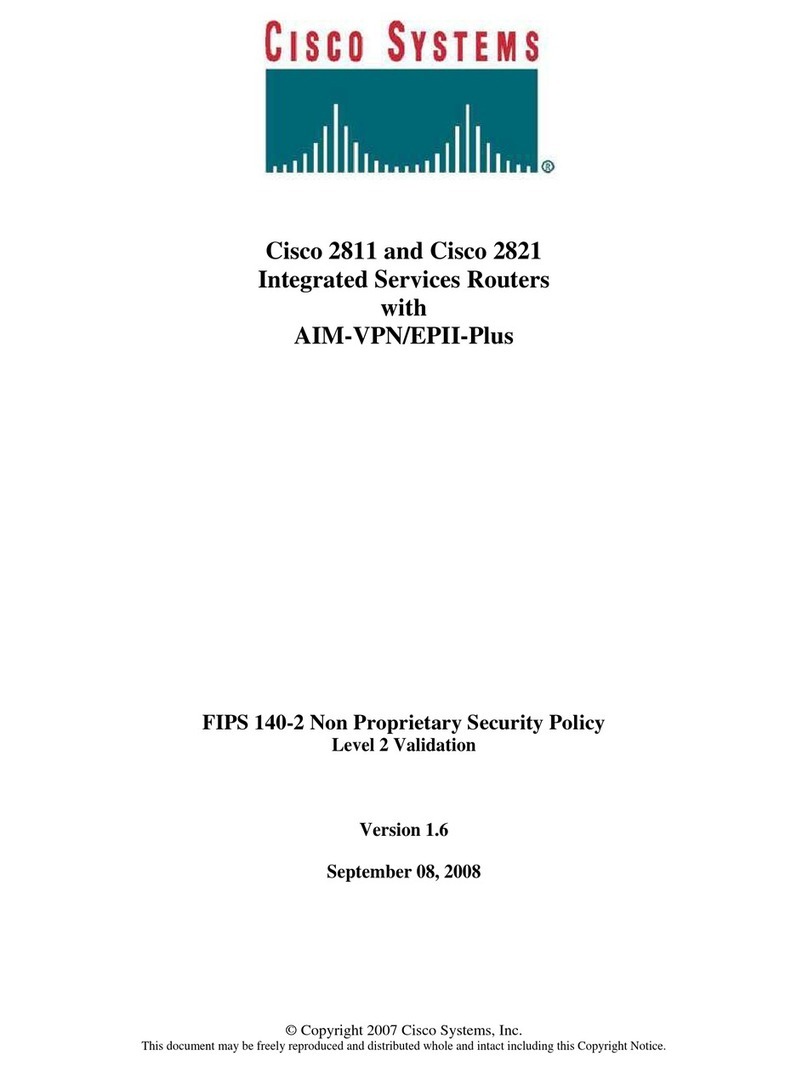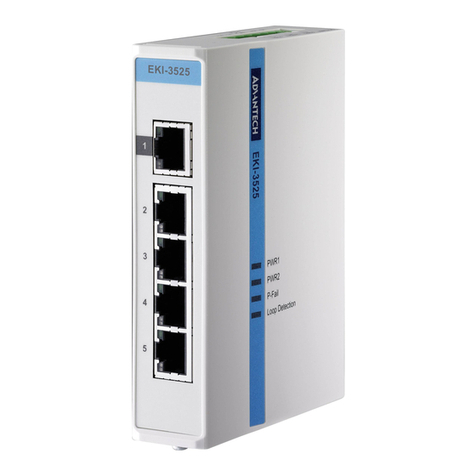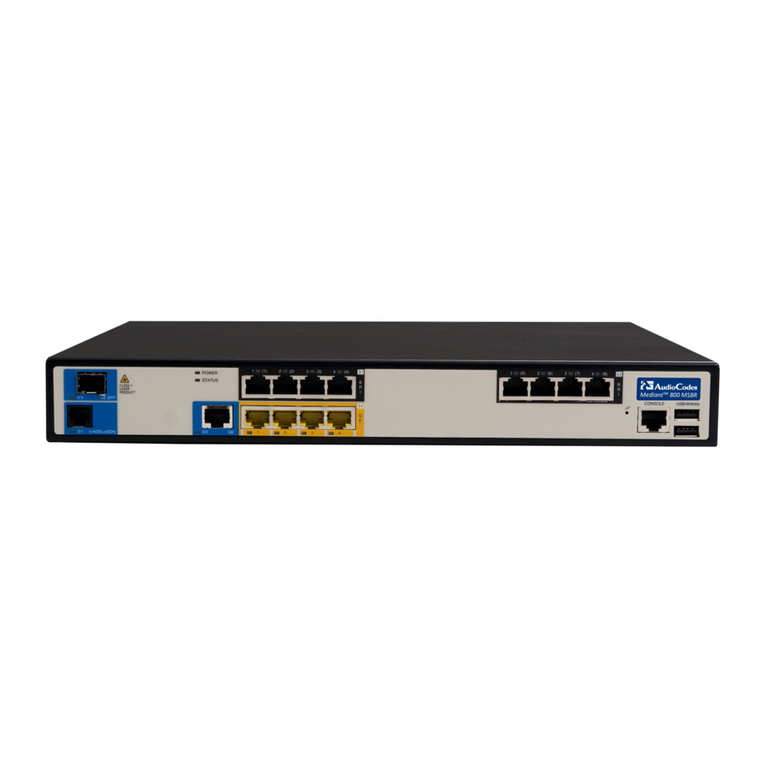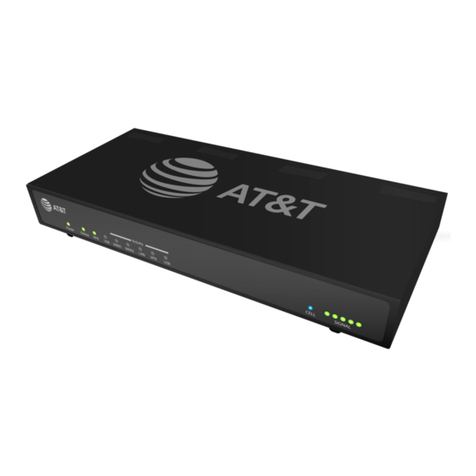BLiNQ X-1200 User manual

BLiNQ Networks Inc.
X-1200 Intelligent Wireless Backhaul System
Installation Guide
Release 1.0
Issue 01 D1
April 2014

BLiNQ Networks Inc. X-1200 System Installation Guide Release 1.0
Confidential - Restricted Use and Duplication Page ii Issue 01 D1
Revision History
Date
Issue
Reason for Issue
August 2013
01
Early Availability
January 2014
1.0
Final Document
April 2014
1.0 D1
Label Update (Approvals); Compliance update including Antenna
Contact Information:
BLiNQ Networks Inc.
400 March Road, Suite 240
Ottawa, ON K2K 3H4
Web Site:
http://www.blinqnetworks.com
Customer Support:
Web: http://www.blinqnetworks.com/support
Telephone: 1-613-599-3388 x270

BLiNQ Networks Inc. X-1200 System Installation Guide Release 1.0
Confidential - Restricted Use and Duplication Page iii Issue 01 D1
Table of Contents
1 Important Safety and Service Notices..........................................................................................1
1.1 Safety Warnings ............................................................................................................................ 1
1.2 Important Service and Warranty Information .............................................................................. 1
1.3 Overvoltage (Lightning/Surge) Protection.................................................................................... 2
2 System Description.....................................................................................................................4
3 Flowchart: Installation Process Overview ....................................................................................7
4 Required Installation Items.........................................................................................................8
5 Site Preparation........................................................................................................................11
5.1 Operating Sector Frequency Check.............................................................................................11
5.2 HM and RBM Pre-Installation Checks and Service Provisioning................................................. 11
6 Installing the Modules (General) ...............................................................................................13
6.1 General Safety Information ........................................................................................................ 13
6.2 Equipment Distance and Orientation ......................................................................................... 14
6.2.1 Hub Modules....................................................................................................................... 14
6.2.2 Remote Backhaul Modules .................................................................................................14
6.3 Mounting to a Pole or Wall.........................................................................................................14
6.3.1 Attaching Pole Clamps to Mounting Bracket......................................................................14
6.3.2 Mounting with U- or V-Clamps ........................................................................................... 16
6.3.3 Mounting with Steel Straps.................................................................................................17
6.3.4 Mounting onto a Wall ......................................................................................................... 18
6.4 Assembling the Module Brackets ............................................................................................... 19
6.4.1 Attach Elevation Bracket..................................................................................................... 19
6.4.2 Attach Azimuth Bracket ...................................................................................................... 21
6.5 Installing the Power Supply Unit (Optional) ............................................................................... 23
6.5.1 Installing the PSU Bracket ...................................................................................................23
6.5.2 Installing the Power Supply Unit.........................................................................................24
6.6 Installing the Module onto a Mounting Bracket......................................................................... 26
6.7 Grounding and Overvoltage Protection Instructions.................................................................. 28
6.7.1 Installing the Grounding Cable............................................................................................ 28
6.7.2 Installing the Lightning/Surge Arrestor............................................................................... 29
6.8 Connecting to DC Power .............................................................................................................31
6.9 Verifying Basic Installation..........................................................................................................33
6.10 Connecting to the Ethernet Backhaul Network ..........................................................................34
6.10.1 Connecting to the RJ45 Ethernet Port ................................................................................34
6.10.2 Connecting to the SFP Port .................................................................................................36
6.11 Cable Management..................................................................................................................... 36

BLiNQ Networks Inc. X-1200 System Installation Guide Release 1.0
Confidential - Restricted Use and Duplication Page iv Issue 01 D1
7 Installing the Hub Module.........................................................................................................38
7.1 Adjusting the Hub Module.......................................................................................................... 38
7.2 Assembling the Beam Steering Antenna (If Required) ...............................................................41
7.2.1 Installing the Bracket on to the Beam Steering Antenna ...................................................41
7.2.2 Mounting the Antenna Assembly on to HM .......................................................................42
7.2.3 Connections for Antenna and Hub...................................................................................... 44
8 Installing the Remote Backhaul Module ....................................................................................46
8.1 Using the BSI Feature and Adjusting the Module....................................................................... 46
9 System and Network Provisioning.............................................................................................51
10 Appendix..................................................................................................................................52
10.1 BLiNQ Wireless Devices and RF Safety/Les appareils sans fil BLiNQ et la sécurité RF................52
10.2 Equipment Compliance............................................................................................................... 54
10.2.1 Federal Communications Commission (FCC) Notices ......................................................... 54
10.2.2 Industry Canada Notice....................................................................................................... 54
10.2.3 Bonded Network .................................................................................................................54
10.3 Troubleshooting Guide ...............................................................................................................55
10.4 List of Acronyms..........................................................................................................................57
List of Figures
Figure 1 Module Casing Labels ....................................................................................................................................2
Figure 2 Hub Module ...................................................................................................................................................6
Figure 3 Remote Backhaul Module..............................................................................................................................6
Figure 4 Pole/Wall Mount Bracket.............................................................................................................................15
Figure 5 Attaching Pole Clamps to Pole/Wall Mount Bracket ...................................................................................15
Figure 6 Attaching Assembled Pole/Wall Mount Bracket to Pole with U-Clamp or V-Clamp....................................17
Figure 7 Attaching Assemble Pole/Wall Mount Bracket to Pole with Straps ............................................................18
Figure 8 Attaching Assembled Pole/Wall Mount Bracket to Wall .............................................................................19
Figure 9 Elevation Bracket and Associated Hardware ...............................................................................................20
Figure 10 Elevation Bracket Mounting Position.........................................................................................................20
Figure 11 Attaching Elevation Bracket to Back of Module ........................................................................................21
Figure 12 Azimuth Bracket and Associated Hardware...............................................................................................21
Figure 13 Attaching Azimuth Bracket to Elevation Bracket on Module.....................................................................22
Figure 14 PSU Mounting Bracket ...............................................................................................................................23
Figure 15 Attaching PSU Bracket to Back of Module .................................................................................................24
Figure 16 Power Supply Unit (PSU)............................................................................................................................24
Figure 17 PSU Bracket PSU Mounting Studs ..............................................................................................................25
Figure 18 Power Connection via the PSU...................................................................................................................26
Figure 19 Module with PSU Installed.........................................................................................................................26
Figure 20 Pole/Wall Mount Bracket Locknut Hardware ............................................................................................26
Figure 21 Unit Installed onto the Pole/Wall Mount Bracket .....................................................................................27

BLiNQ Networks Inc. X-1200 System Installation Guide Release 1.0
Confidential - Restricted Use and Duplication Page v Issue 01 D1
Figure 22 Module with Grounding Lug ......................................................................................................................29
Figure 23 Wiring of Lightning/Surge Arrester (Sold by BLiNQ Networks)..................................................................31
Figure 24 HM and RBM LED States ............................................................................................................................33
Figure 25 Ethernet Connector Encased in Environmental Housing ...........................................................................34
Figure 26 Ethernet Connector Assembly - Separated................................................................................................35
Figure 27 Module Cable Management ......................................................................................................................37
Figure 28 Hub Module Showing All Connectors ........................................................................................................38
Figure 29 HM Horizontal Plane Adjustment via Azimuth Bracket .............................................................................39
Figure 30 HM Vertical Plane Adjustment via Elevation Bracket ................................................................................39
Figure 31 HM Theta Adjustment Via Elevation Bracket Mounting Holes ..................................................................40
Figure 32 HM Down-tilt Adjustment with Antenna Mount .......................................................................................40
Figure 33 Beam Steering Antenna Mounting Bracket ...............................................................................................41
Figure 34 Hub Module Antenna Mounting Holes ......................................................................................................43
Figure 35 Antenna attached to a Hub Module ..........................................................................................................43
Figure 36 Beam Steering Antenna RF Connections ...................................................................................................44
Figure 37 RF Connections on the Hub Module ..........................................................................................................44
Figure 38 RBM Module Showing All Connectors .......................................................................................................46
Figure 39 RBM Horizontal Plane Adjustment via Azimuth Bracket ...........................................................................48
Figure 40 RBM Vertical Plane Adjustment via Elevation Bracket ..............................................................................48
Figure 41 RBM Theta Adjustment Via Elevation Bracket Mounting Holes ................................................................49
List of Tables
Table 1 X-1200 System Specifications..........................................................................................................................4
Table 2 Required Items for Hub Module Installation ..................................................................................................8
Table 3 Required Items for Remote Backhaul Module Installation .............................................................................9
Table 4 Summary of Required Installation Tools (Not Provided by BLiNQ Networks) ................................................9
Table 5 Recommended Torque Values for Self-Tapping Bolts...................................................................................15
Table 6 Recommended Torque Values for U-Bolt or V-Clamp Bolts .........................................................................16
Table 7 Recommended Torque Values for Elevation Bracket Bolts...........................................................................20
Table 8 Recommended Torque Values for Azimuth Bracket Bolts ............................................................................22
Table 9 Recommended Torque Values for PSU Bracket Bolts ...................................................................................23
Table 10 Recommended Torque Values for PSU Bolts ..............................................................................................25
Table 11 Recommended Torque Values for Pole/Wall Mount Bracket Locknuts......................................................27
Table 12 Recommended Torque Value for the RJ45 Ethernet Connection ...............................................................34
Table 13 Recommended Torque Values for HM Bracket Bolts..................................................................................39
Table 14 Recommended Torque Values for Antenna Bracket Nuts ..........................................................................42
Table 15 Recommended Torque Values for Antenna Bracket Bolts..........................................................................42
Table 16 Recommended Torque Values for Antenna Cable Connections .................................................................44
Table 17 Recommended Torque Values for RBM Bracket Bolts................................................................................47
Table 18 X-1200 System Troubleshooting Guide.......................................................................................................55
Table 19 List of Acronyms ..........................................................................................................................................57

BLiNQ Networks Inc. X-1200 System Installation Guide Release 1.0
Confidential - Restricted Use and Duplication Page vi Issue 01 D1
This Page Intentionally Left Blank.

BLiNQ Networks Inc. X-1200 System Installation Guide Release 1.0
Confidential - Restricted Use and Duplication Page 1 Issue 01 D1
1Important Safety and Service Notices
Read this X-1200 System Installation Guide and follow all operating and safety instructions.
Installation of the X-1200 system must be done by a qualified professional installer who is experienced
with installing telecommunications equipment and networks. Installations must adhere to the
information and specifications within this X-1200 System Installation Guide.
1.1 Safety Warnings
WARNING!
Follow all health and safety procedures and recommendations made by
BLiNQ Networks within this X-1200 System Installation Guide. Failure
to do so could result in injury, death, or damage to the equipment.
The product-marketing label indicates the power requirements. Do not exceed the described
limits.
Each module’s power supply must have a resettable circuit breaker rated to a maximum of 20
Amps.
The antenna must be permanently grounded before making any of the connections to the
antenna used with the Hub.
Use only a damp cloth for cleaning. Do not use liquid or aerosol cleaners. Disconnect the power
before cleaning.
Disconnect the power when the unit is stored for long periods.
Do not locate the outdoor unit near power lines or other electrical power circuits.
The system must be properly grounded to protect against power surges and accumulated static
electricity. It is the user’s responsibility to install this device in accordance with the local electrical
codes.
1.2 Important Service and Warranty Information
Keep all product information for future reference.
Refer all repairs to qualified service personnel. Do not remove the covers or modify any part of the
X-1200 system, as this action will void the warranty.
Be sure to do the following upon unpacking the X-1200 system modules. For each Hub Module (HM) and
Remote Backhaul Module (RBM) in your system:
Locate the label on the module casing that lists the Serial Number (SN) and Media Access Control
(MAC) address for the module (Figure 1, “Module Casing Labels”)
Record the SN on your registration card for future reference
Record the MAC address for future reference when provisioning the system
!

BLiNQ Networks Inc. X-1200 System Installation Guide Release 1.0
Confidential - Restricted Use and Duplication Page 2 Issue 01 D1
Figure 1 Module Casing Labels
1.3 Overvoltage (Lightning/Surge) Protection
WARNING!
A qualified professional installer should install the wireless equipment.
The installer must follow local and national codes for electrical
grounding and safety. Failure to meet safety requirements and/or use
of non-standard practices and procedures could result in personal
injury and damage to equipment. A direct lightning strike may cause
serious damage even if these guidelines are followed.
All outdoor wireless equipment is susceptible to lightning damage from a direct hit or induced current
from a near strike. Lightning protection and grounding practices in local and national electrical codes
serve to minimize equipment damage, service outages and serious injury. Reasons for lightning damage
can be summarized as follows:
Poorly grounded antenna sites that can conduct high lightning strike energy into equipment.
Lack of properly installed lightning protection equipment that can cause equipment failures from
lightning induced currents.
An overvoltage protection system provides a means by which the energy may enter earth without
passing through and damaging parts of a structure. An overvoltage protection system does not prevent
lightning from striking; it provides a means for controlling it and preventing damage by providing a low
resistance path for the discharge of energy to travel safely to ground. Improperly grounded connections
are also a source of noise that can cause sensitive equipment to malfunction.
A good grounding system disperses most of the surge energy from a lightning strike away from the
building and equipment. The remaining energy on the cable can be directed safely to ground through a
lightning/surge arrestor in series with the cable.
!

BLiNQ Networks Inc. X-1200 System Installation Guide Release 1.0
Confidential - Restricted Use and Duplication Page 3 Issue 01 D1
The X-1200 system is designed with consideration for resistance to the effects of lightning on the access
point electronics. When installing a lightning/surge arrestor for your system installation, observe the
following general industry practices:
Install lightning/surge arrestors in series with the Ethernet and power cables at the point of entry
to the building. If the power cable does not enter the building, the location is at the installer’s
discretion.
In each case the grounding wire should be connected to the same termination point used for the
tower or mast.
Provide direct grounding from the unit, the mounting bracket, the antenna, and the Ethernet
cable surge protection to the same ground bus on the building. Use the grounding screws
provided for terminating the ground wires.

BLiNQ Networks Inc. X-1200 System Installation Guide Release 1.0
Confidential - Restricted Use and Duplication Page 4 Issue 01 D1
2System Description
The X-1200 is a dual carrier, Point-to-Multipoint (PMP) intelligent wireless transport system
distinguished for its high performance and advanced traffic management capabilities. The X-1200
platform consists of a Hub Module (HM) and up to four (eight
1
) Remote Backhaul Modules (RBM).
BLiNQ Networks X-1200 system operates in the sub 6 GHz licensed frequency bands. It offers
deployment flexibility for both Line-of-Sight (LOS) and Non Line-of-Sight (TrueNLOS™) operation by
incorporating advanced Physical Layer (PHY) and Media Access Control (MAC) layer algorithms and
techniques. BLiNQ Networks has developed proprietary interference mitigation algorithms and
incorporated self-organizing network techniques into its solutions to increase capacity and reliability
beyond that of ordinary backhaul solutions. This is because in a NLOS environment, interference and
shadowing are the two main reasons that limit capacity and link reliability. Mitigating interference and
enhancing signal reliability maximizes system performance.
The X-1200 system delivers 11 bps/Hz spectral efficiency. The system is designed for use in multiple
applications that include small cell mobile backhaul, optical fiber cable extension and enterprise data
backhaul services by providing up to 400 Mbps of throughput in dual 2x20 MHz channels.
Table 1 lists the system specifications.
Table 1 X-1200 System Specifications
RADIO SPECIFICATIONS
Frequency Band
3.65-3.70 GHz, 3.40-3.60 GHz, 2.50-2.69 GHz, and 5.47-5.875 GHz
Tuning Resolution
50 kHz, minimum
Transmit Power, 3.65 GHz
-15 dBm to +27 dBmper port, 0.25 dB resolution
Transmit Power, 5.8 GHz
-15 dBm to +23 dBmper port, 0.25 dB resolution
Channel Bandwidth
20 MHz (5/10 MHz1)
Receiver Sensitivity
-92 dBm with QPSK @ 1e-03 PER (typ.)
Modulation & Coding
QPSK/16QAM/64QAM/256QAM, bi-directional, fully adaptive
PERFORMANCE
Throughput
Up to 400 Mbps, L2 aggregate uplink and downlink
Spectral Efficiency
11 bps/Hz
Physical Layer
Cyclic Single Carrier Frequency Domain Equalized
Operating Mode
TDD
Latency
3.5 msec for 4 RBM’s assigned to Hub, dual carrier mode
Traffic ratios
50:50, 65:35, 75:25, 35:65, 25:75; user configurable
Frame Size
Up to 2016 bytes
1
Future Software Release
Licensed:+26dBm for MCS 7 and +25dBm for MCS 8; Unlicensed: +22dBm for MCS 6, +21 for MCS 7 and +20 for MCS 8

BLiNQ Networks Inc. X-1200 System Installation Guide Release 1.0
Confidential - Restricted Use and Duplication Page 5 Issue 01 D1
PERFORMANCE (Cont)
Antenna System
2x2 MIMO, Spatial Multiplexing / Tx & Rx Diversity
Remote Backhaul Module: Integral antenna, 14 dBi
Hub Module: Beam Steering Antenna, 17 dBi
Configuration
PTP or PMP up to 42Remotes
Power Consumption
< 72 W
Power
-48 Vdc nominal, -36 to -60 Vdc range
Connectivity
Copper 1000BaseT
Optional Fiber Gig-E (Hub only)
Synchronization
Integral GPS antenna and receiver, 1588v2, SyncE
QoS
8 queues per service flow, 4 SF’s per RBM per direction
Security
AES-256
NETWORKING
Configuration
Ethernet bridge
Attributes
802.1Q, 802.1ad, DSCP/ToS/802.1p (IPv4/IPv6)
Features
Per RBM service flows, Dynamic Bandwidth Sharing
OPERATIONS, ADMINISTRATION AND MANAGEMENT (OAM)
Configuration
WebUI / CLI, radio and Ethernet performance monitoring
EMS Integration
SNMP v2c/v3
OAM Protocols
HTTP(S), TCP/IP, UDP, (S)FTP, SSH
MECHANICAL/ENVIRONMENTAL/COMPLIANCE
RBM Dimensions
12.6” x 8.3” x 5.1” (32 x 21 x 13 cm)
Hub Dimensions
15.0” x 18.0” x 5.1” (38 x 46 x 13 cm)
Weight (Hub & RBM)
RBM < 8.8 lbs. (4.0 kg); Hub < 15.5 lbs. (7.0 kg)
Temperature Range
-45°C to +55°C (-49 °F to 131 °F)
Enclosure Protection
IP67
Compliance
EMC: FCC Part 15 Subpart B, C, E; ICES-003 Class B
Radio: FCC Part 90z, RSS 197
Safety: UL/CSA 60950-1,-22
The X-1200 system operates in licensed Time Division Duplexing (TDD) bands including 3.65-3.70 GHz,
3.40-3.60 GHz, 2.50-2.69 GHz bands in both Point-to-Point (PTP) and Point-to-Multipoint (PMP)
configurations. Additionally, the X-1200, when configured for dual-carrier mode, operates in unlicensed
frequency bands including 5.47-5.875 GHz bands. It incorporates Multiple Input Multiple Output
(MIMO) technology and operates at high Modulation and Coding Scheme (MCS) rates to provide high
capacity. In addition, the product incorporates BLiNQ Networks interference management techniques
which include multiple power control algorithms to maximize performance in dense networks.
2
8 in future release

BLiNQ Networks Inc. X-1200 System Installation Guide Release 1.0
Confidential - Restricted Use and Duplication Page 6 Issue 01 D1
The X-1200 system has a small, all-outdoor, zero-footprint form factor that can be easily deployed
unobtrusively on towers, poles, building sidewalls or rooftops. It consists of the following modules:
Hub Module (HM): A sector controller which serves as the aggregation point controlling up to 4
Remote Backhaul Modules (RBMs), featuring an integral Beam Steering Antenna.
Figure 2 Hub Module
Remote Backhaul Module (RBM): A subscriber unit that is installed outdoors on customer
premises, including public infrastructure assets such as light and utility poles in mobile backhaul
applications. RBMs feature an integrated antenna.
Figure 3 Remote Backhaul Module
8 in future software release.
Front
Back
Front without Antenna
Back
Side

BLiNQ Networks Inc. X-1200 System Installation Guide Release 1.0
Confidential - Restricted Use and Duplication Page 7 Issue 01 D1
3Flowchart: Installation Process Overview
To get started quickly, follow the process below. For more details, click on the chapter/section title.
Start
Important
Safety and
Service
Notices
PAGE 1
Required
Installation
Items
PAGE 8
Site
Preparation
PAGE 11
Installing
the Modules
(General)
PAGE
13
Installing
the Hub
Module
PAGE 38
Installing the
Remote
Backhaul
Module
PAGE 46
System and
Network
Provisioning
PAGE
51
Safety
Warnings
Important
Service and
Warranty
Information
Overvoltage
(Lightning/Surge)
Protection
Operating
Sector
Frequency
Check
HM and
RBM Pre-
Installation
Checks and
Service
Provisioning
General
Safety
Information
Adjusting
the Hub
Module
Using the
BSI Feature
and
Adjusting
the Module
Equipment
Distance
and
Orientation
Mounting to
a Pole or
Wall
Assembling
the Module
Brackets
Installing
the Power
Supply Unit
(Optional)
Installing
the Module
onto a
Mounting
Bracket
Grounding
and
Overvoltage
Protection
Instructions
Connecting
to DC Power
Verifying
Basic
Installation
Connecting
to the
Ethernet
Backhaul
Network
END
Assembling
the Beam
Steering
Antenna (If
Required)
Cable
Management

BLiNQ Networks Inc. X-1200 System Installation Guide Release 1.0
Confidential - Restricted Use and Duplication Page 8 Issue 01 D1
4Required Installation Items
Table 2 lists the items required to install the X-1200 Hub Module (HM).
Table 3 lists the items required to install the X-1200 Remote Backhaul Module (RBM).
Table 4 lists the tools required to install the X-1200 system modules.
Table 2 Required Items for Hub Module Installation
No.
Description
Quantity
Note
1
X-1200 Hub Module (HM)
Beam Steering Antenna Kit includes Antenna unit, Down-tilt antenna
bracket, screws, nuts and washers for mounting to X-1200 unit, SPI
control cable (x1), and RF cables NType to NType (x4)
1
2
X-1200 Module Mount Kit with Self-Tapping Screw Bolts—Includes
module elevation bracket, module azimuth bracket, two pole clamps,
and pole/wall mount bracket
1*
Screws not
provided for
wall/mast side
(1/4 in. holes)
3
Coaxial RF Cables: N-type male termination at both ends, outdoor rated
2 or 4*
Nominal 1 m long
4
Outdoor-rated Shielded Ethernet cable, CAT5e or better
< 100
meters
Not provided by
BLiNQ Networks
5
Ethernet cable connector and environmental housing with shielded
RJ45 connectors
1
Provided by
BLiNQ Networks
6
SFP, fiber and connectors (if optional fiber optic Ethernet possibility is
to be used)
Not provided by
BLiNQ Networks
7
Power Cable:
Shielded 18 AWG 2 conductors 90C water resistant, black and white
conductor jackets, outdoor rated cable, 5-8 mm thick
Power Connector:
Weatherized DC connector to fit on power cable
1*
Option of 10m,
20m, 40m
terminated
cables
8
6-gauge grounding cable
1
Not provided by
BLiNQ Networks
9
Power Supply Unit (PSU) Kit includes PSU, PSU bracket and associated
hardware for installation.
1*
Optional
10
Lightning/Surge Arrester
1*
Optional
11
Access to NOC Server, Providing FTP, SysLog, SNMP Browser, and DNS
Services
1
12
Basic Portable Personal Computer (PC); with NIC (Ethernet) port
required
1
Not Provided by
BLiNQ Networks
13
Miscellaneous hardware and software as required: for example,
compass, sniffer application, FTP client
as
required
Not Provided by
BLiNQ Networks
*Sold as a separate line item by BLiNQ Networks.

BLiNQ Networks Inc. X-1200 System Installation Guide Release 1.0
Confidential - Restricted Use and Duplication Page 9 Issue 01 D1
Table 3 Required Items for Remote Backhaul Module Installation
No.
Description
Quantity
Note
1
X-1200 Remote Backhaul Module (RBM)
1
Per site
2
X-1200 Module Mount Kit with Self-Tapping Screw Bolts—Includes
module elevation bracket, module azimuth bracket, two pole
clamps, and pole/wall mount bracket
1*
Screws not provided
for wall/mast side
(1/4 in. holes)
3
Outdoor-rated Shielded Ethernet cable, CAT5e or better
< 100
meters
Not provided by
BLiNQ Networks
4
Ethernet cable connector and environmental housing with shielded
RJ45 connectors
1
Provided by BLiNQ
Networks
5
Power Cable:
Shielded 18 AWG 2 conductors 90C water resistant, black and
white conductor jackets, outdoor rated cable, 5-8 mm thick
Power Connector:
Weatherized DC connector to fit on power cable
1*
Option of 10m, 20m,
40m connectorized
cables
6
6-gauge grounding cable
1
Not provided by
BLiNQ Networks
7
Lightning/Surge Arrester
1*
Optional
8
Access to NOC Server, Providing FTP, SysLog, SNMP Browser, and
DNS Services
1
9
Basic Portable Personal Computer (PC); with NIC (Ethernet) port
required
1
Not provided by
BLiNQ Networks
10
Miscellaneous hardware and software as required:
for example, wrench, compass
as required
Not provided by
BLiNQ Networks
11
Power Supply Unit (PSU) Kit includes PSU, PSU bracket and
associated hardware
1 each*/
RBM
Optional
*Sold as a separate line item by BLiNQ Networks.
Table 4 Summary of Required Installation Tools (Not Provided by BLiNQ Networks)
No.
Description
1
Socket wrench with 3/8 in. driver head, with long and short ½ in. and 7/16 in. sockets
2
Slot head screwdrivers, small and medium size
3
Phillips #2 screwdriver
4
Torque wrench, 3/8 in. head with range for 4-60Nm or 3-45lbf-ft
5
Ratchet wrenches, ½ in. and 7/16 in.
6
Steel straps (for installation on pole diameters 3.5 in./9 cm or larger)
7
Four 5/16 in. or M8 wall mounting bolts, or equivalent, for wall installation (and bolt reinforcement
hardware if wall material requires it)
8
Black marker
9
Crimp tool
10
Cable ties
11
Torque screwdriver ¼ head with 5-40inlb range
12
Allen drivers metric 3mm and SAE 3/16” for GND lug and Beam Steering Antenna bracket

BLiNQ Networks Inc. X-1200 System Installation Guide Release 1.0
Confidential - Restricted Use and Duplication Page 10 Issue 01 D1
No.
Description
13
Metric 7mm nut driver (socket) for the power supply mounting nuts
14
Metric 8mm nut driver (socket) for Beam Steering Antenna studs mounting to bracket

BLiNQ Networks Inc. X-1200 System Installation Guide Release 1.0
Confidential - Restricted Use and Duplication Page 11 Issue 01 D1
5Site Preparation
To prepare the installation site, perform the following checks prior to installation of an X-1200 Hub
Module (HM) or Remote Backhaul Module (RBM).
Section 5.1, “Operating Sector Frequency Check”, page 11
Section 5.2, “HM and RBM Pre-Installation Checks and Service Provisioning”, page 11
5.1 Operating Sector Frequency Check
The operating frequency must be determined prior to the installation and be based on a cell site
frequency plan. BLiNQ Networks strongly advises that a comprehensive site survey be performed before
installation to determine the optimum antenna orientation and identify any potential source of
interference.
5.2 HM and RBM Pre-Installation Checks and Service
Provisioning
This section requires use of the BLiNQ X-1200 WebUI. The X-1200 WebUI is the configuration tool for
use with X-1200 HMs and RBMs. It is a standard web application that runs directly on the X-1200
equipment through the default port for HTTP (that is, port 80), and is accessible at URL http://<IP of the
node>.
For instructions on how to use the X-1200 WebUI, refer to the X-1200 System User Guide.The default
username and password for access is: admin.
Browser support for X-1200 WebUI:
Mozilla Firefox
Internet Explorer 9 (IE9)
WebKit-based browsers, for example:
Apple Safari
Google Chrome
Operating System (OS) support for X-1200 WebUI:
Windows
Mac OS X
Linux
Note: With the exception of IE9, both web browser and OS support for the X-1200 WebUI always refer
to the most recent versions.
The default configuration settings on the HM and RBM include:
Fixed, non-routable local craft IP address: 169.254.1.1
Management IP address: 192.168.26.2
Operating Frequency (e.g. 3.65 GHz)
Channel bandwidth (20 MHz)

BLiNQ Networks Inc. X-1200 System Installation Guide Release 1.0
Confidential - Restricted Use and Duplication Page 12 Issue 01 D1
Uplink/downlink TDD ratio on the Hub
Preamble series index value
RF transmitter disabled on the HM (not transmitting)
Perform the following pre-installation checks and service provisioning on the HM and RBMs:
1. Verify the modules can be powered up and Ethernet connectivity can be established.
2. Verify and record the Media Access Control (MAC) address of each RBM unit (located on the label
on the outside of the unit).
3. Using the X-1200 WebUI for HMs:
a. Verify the configuration settings on the HM and update if necessary.
b. Verify the active software version on the HM and upgrade if necessary.
c. To allow the HM to go into service after installation, provision these HM radio operation
parameters through the ‘Setup > Radio Interface Page’either before or after installation:
Radio Administrative State (set to ‘Enabled’)
RF Frequency
Max. Transmit Power
Preamble Phase Index (Optional)
Rate Adaption (Optional)
d. (Optional) Provision these HM system parameters as needed through the ‘Setup > System Page’
either before or after installation:
System Identification (including Name, Location, Contact, Description)
Ethernet Port Configuration
Management Interface IP Address
For more information, refer to the X-1200 System User Guide.
4. Using the X-1200 WebUI for RBMs:
a. Verify the configuration settings on each RBM and update if necessary.
b. Verify the active software version on each RBM and upgrade if necessary.
c. To allow the RBM to go into service after installation, provision these RBM radio operation
parameters through the ‘Setup > Radio Interface Page’ either before or after installation:
Radio Administrative State (set to ‘Enabled’)
d. (Optional) Provision these RBM system parameters as needed through the ‘Setup > System Page’
either before or after installation:
System Identification (including Name, Location, Contact, Description)
Ethernet Port Configuration
Management Interface IP Address
For more information, refer to the X-1200 System User Guide.

BLiNQ Networks Inc. X-1200 System Installation Guide Release 1.0
Confidential - Restricted Use and Duplication Page 13 Issue 01 D1
6Installing the Modules (General)
As needed, refer to these sections and follow these steps to properly install either the Hub Module (HM)
or Remote Backhaul module (RBM):
Section 6.1, “General Safety Information”, page 13
Section 6.2, “Equipment Distance and Orientation”, page 14
Section 6.3, “Mounting to a Pole or Wall”, page 14
Section 6.3.1, “Attaching Pole Clamps to Mounting Bracket”, page 16
Section 6.3.2, “Mounting with U- or V-Clamps”, page 17
Section 6.3.3, “Mounting with Steel Straps”, page 17
Section 6.3.4, “Mounting onto a Wall”, page 18
Section 6.4, “Assembling the Module Brackets”, page 19
Section 6.4.1, “Attach Elevation Bracket”, page 19
Section 6.4.2, “Attach Azimuth Bracket”, page 21
Section 6.5, “Installing the Power Supply Unit (Optional)”, page 23
Section 6.6, “Installing the Module onto a Mounting Bracket”, page 26
Section 6.7, “Grounding and Overvoltage Protection Instructions”, page 28
Section 6.8, “Connecting to DC Power”, page 31
Section 6.9, “Verifying Basic Installation”, page 33
Section 6.10, “Connecting to the Ethernet Backhaul Network”, page 34
Section 6.11, “Cable Management”, Page 36
6.1 General Safety Information
Before performing any of the tasks in this chapter, read the safety warnings and service notices in
Chapter 1, “Important Safety and Service Notices”.
The system requires one person to properly and safely install the X-1200 system modules.
WARNING!
Installation of the equipment must comply with local and national
electrical codes.
Personnel mounting the equipment must understand grounding
methods.
!

BLiNQ Networks Inc. X-1200 System Installation Guide Release 1.0
Confidential - Restricted Use and Duplication Page 14 Issue 01 D1
6.2 Equipment Distance and Orientation
6.2.1 Hub Modules
Locate the Hub Module (HM) with as much distance as possible from other transmitting equipment.
The installer must mount the Beam Steering Antenna on the HM, as it can not be remotely mounted.
The HM must also have clear view of the sky for its Global Positioning System (GPS) antenna (located on
top of the unit) to work and to synchronize transmissions with other HMs.
When mounting the HM, ensure it is oriented so that the cable connectors/connections point downward
and the GPS antenna points upward.
6.2.2 Remote Backhaul Modules
When installing multiple Remote Backhaul Modules (RBMs), the distance required between the RBMs
depends on the average transmit power in use by the RBMs. Contact your supplier for the
recommended distance between RBMs for your particular installation.
When mounting the RBMs, ensure they are oriented so that the power cable connectors point
downward.
6.3 Mounting to a Pole or Wall
The following sections describe how to attach a mounting bracket to either a pole or wall:
Section 6.3.1, “Attaching Pole Clamps to Mounting Bracket”; recommended for pole diameters
up to 4 in./10 cm.
Section 6.3.2, “Mounting with U- or V-Clamps”; recommended for pole diameters up to
4 in./10 cm
Section 6.3.3, “Mounting with Steel Straps”; recommended for pole diameters up to 3.5 in./9 cm
or larger
Section 6.3.4, “Mounting onto a Wall”
6.3.1 Attaching Pole Clamps to Mounting Bracket
Use the pole clamps with pole/wall mounting brackets for pole diameters up to 4 in./10 cm. If the pole is
larger, see Section 6.3.3, “Mounting with Steel Straps”.
Required parts and tools:
Two pole clamps, pole/wall mount bracket (Figure 4, “Pole/Wall Mount Bracket”)
Socket wrench with 3/8 in. driver head, with long and short ½ in. and 7/16 in. sockets
Torque wrench, 3/8 in. head with range for 4-60Nm or 3-45lbf-ft
Table of contents

